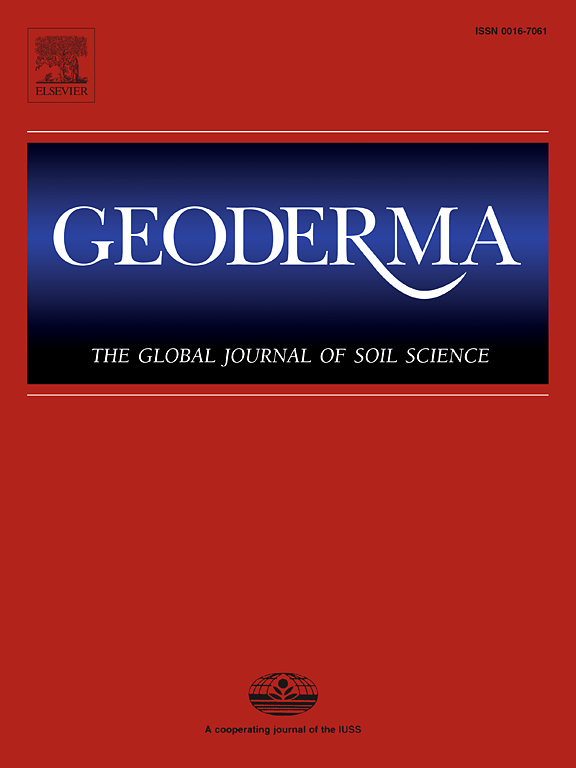Physicochemical protection is more important than chemical functional composition in controlling soil organic carbon retention following long-term land-use change
IF 6.6
1区 农林科学
Q1 SOIL SCIENCE
引用次数: 0
Abstract
Understanding the mechanisms that control soil organic carbon (SOC) persistence is central to soil management and climate change mitigation. In the present study, we utilised a chronosequence of Vertisols which have undergone land use change from native vegetation to cropping for up to 82 y in subtropical Australia. We examined whether the marked changes in SOC concentrations were associated with changes in the physicochemical protection of SOC in aggregate structures (occlusion) and mineral surfaces (adsorption) or with changes in chemical functional composition. Soil samples were fractionated using density and physical fractionation to isolate the free particulate organic matter (fPOM), occluded POM (oPOM) and fine mineral-associated organic matter (fine-MAOM) to assess the impact of land use change on soil organic matter (SOM) fractions with differing degrees of physicochemical protection. The impact of long-term cropping on SOC functional group composition across soil fractions was assessed using synchrotron-based near edge X-ray absorption fine structure (NEXAFS) analyses. We found that although long-term cropping caused a loss of 43 % of bulk SOC after 20 y, this marked loss over time was not associated with a change in C functional group composition. Furthermore, although the SOC retention in the various fractions differed up to 60-fold (fPOM-C decreased by 78 % after cropping for 20 y, whilst fine-MAOM decreased by 25 %), there were only comparatively minor differences in SOC functional group composition between these fractions. Together, these findings suggest that the differences in C retention between fractions were less related to SOC functional group composition and more related to SOM’s physicochemical protection.
在控制长期土地利用变化后的土壤有机碳保留方面,物理化学保护比化学功能成分更重要
了解控制土壤有机碳(SOC)持久性的机制对于土壤管理和减缓气候变化至关重要。在本研究中,我们利用了澳大利亚亚热带地区长达 82 年时间里从原生植被到种植业的土地利用变化的维提斯土壤年序列。我们研究了 SOC 浓度的显著变化是与 SOC 在聚集结构(闭塞)和矿物表面(吸附)中的物理化学保护变化有关,还是与化学功能成分的变化有关。利用密度分馏和物理分馏对土壤样本进行分馏,分离出游离颗粒有机质(fPOM)、闭锁有机质(oPOM)和细小矿物相关有机质(fine-MAOM),以评估土地利用变化对具有不同理化保护程度的土壤有机质(SOM)组分的影响。利用同步辐射近边缘 X 射线吸收精细结构(NEXAFS)分析评估了长期耕作对土壤各组分 SOC 功能群组成的影响。我们发现,虽然长期耕作会导致大量 SOC 在 20 年后损失 43%,但这种随时间推移的明显损失与 C 功能团组成的变化无关。此外,虽然各部分的 SOC 保留率相差高达 60 倍(种植 20 年后,fPOM-C 减少了 78%,而细 MAOM 减少了 25%),但这些部分之间的 SOC 功能群组成差异相对较小。总之,这些发现表明,不同部分之间的碳保留差异与 SOC 功能群组成的关系不大,而与 SOM 的物理化学保护作用关系更大。
本文章由计算机程序翻译,如有差异,请以英文原文为准。
求助全文
约1分钟内获得全文
求助全文
来源期刊

Geoderma
农林科学-土壤科学
CiteScore
11.80
自引率
6.60%
发文量
597
审稿时长
58 days
期刊介绍:
Geoderma - the global journal of soil science - welcomes authors, readers and soil research from all parts of the world, encourages worldwide soil studies, and embraces all aspects of soil science and its associated pedagogy. The journal particularly welcomes interdisciplinary work focusing on dynamic soil processes and functions across space and time.
 求助内容:
求助内容: 应助结果提醒方式:
应助结果提醒方式:


